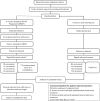Implementation of the Symptom Navi © Programme for cancer patients in the Swiss outpatient setting: a study protocol for a cluster randomised pilot study (Symptom Navi© Pilot Study)
- PMID: 31289075
- PMCID: PMC6615799
- DOI: 10.1136/bmjopen-2018-027942
Implementation of the Symptom Navi © Programme for cancer patients in the Swiss outpatient setting: a study protocol for a cluster randomised pilot study (Symptom Navi© Pilot Study)
Abstract
Introduction: Self-management interventions show promising results on symptom outcomes and self-management behaviours. The Symptom Navi© Programme (SN©P) is a nurse-led intervention supporting patients' symptom self-management during anticancer treatment. It consists of written patient information (Symptom Navi© Flyers (SN©Flyers)), semistructured consultations and a training manual for nurses.
Methods and analysis: This pilot study will evaluate the implementation of the SN©P based on the Reach Effectiveness-Adoption Implementation Maintenance framework at Swiss outpatient cancer centres. We will use a cluster-randomised design and randomise the nine participating centres to the intervention or usual care group. We expect to include 140 adult cancer patients receiving first-line systemic anticancer treatment. Trained nurses at the intervention clusters will provide at least two semistructured consultations with the involvement of SN©Flyers. Outcomes include patients' accrual and retention rates, patient-reported interference of symptoms with daily functions, symptom burden, perceived self-efficacy, quality of nursing care, nurse-reported facilitators and barriers of adopting the programme, nurses' fidelity of providing the intervention as intended, and patients' safety (patients timely reporting of severe symptoms). We will use validated questionnaires for patient-reported outcomes, focus group interviews with nurses and individual interviews with oncologists. Linear mixed models will be used to analyse patient-reported outcomes. Focus group and individual interviews will be analysed by thematic analysis.
Ethics and dissemination: The Symptom Navi© Pilot Study has been reviewed and approved by Swiss Ethic Committee Bern (KEK-BE: 2017-00020). Results of the study will be disseminated in peer-reviewed journal and at scientific conferences.
Trial registration number: NCT03649984; Pre-results.
Keywords: Nurses/nursing; RE-AIM framework; implementation research; self-efficacy; symptom self-management.
© Author(s) (or their employer(s)) 2019. Re-use permitted under CC BY-NC. No commercial re-use. See rights and permissions. Published by BMJ.
Conflict of interest statement
Competing interests: SP has received education grants, provided consultation, attended advisory boards and/or provided lectures for: Abbvie, Amgen, AstraZeneca, Bayer, Biocartis, BoehringerIngelheim, Bristol-Myers Squibb, Clovis, Daiichi Sankyo, Debiopharm, Eli Lilly, F Hoffmann-La Roche, Foundation Medicine, Illumina, Janssen, Merck Sharp and Dohme, Merck Serono, Merrimack, Novartis, Pharma Mar, Pfizer, Regeneron, Sanofi, Seattle Genetics and Takeda , from whom she has received honoraria. ME received education grants, provided consultation, attended advisory boards and/or provided lectures for: Vifor, Roche, and Bristol-Myers Squibb. All other authors have no competing interests to declare.
Figures

Similar articles
-
Development and implementation strategies of a nurse-led symptom self-management program in outpatient cancer centres: The Symptom Navi© Programme.Eur J Oncol Nurs. 2020 Feb;44:101714. doi: 10.1016/j.ejon.2019.101714. Epub 2019 Dec 20. Eur J Oncol Nurs. 2020. PMID: 31954227
-
[Flyer to improve self-management of symptoms for patients with cancer – Evaluation of feasibility and comprehensibility of the Symptom Navi].Pflege. 2017;30(3):151-160. doi: 10.1024/1012-5302/a000518. Epub 2016 Nov 30. Pflege. 2017. PMID: 27901407 German.
-
Pilot Testing of a Nurse-Led Basic Symptom Self-management Support for Patients Receiving First-Line Systemic Outpatient Anticancer Treatment: A Cluster-Randomized Study (Symptom Navi Pilot Study).Cancer Nurs. 2021 Nov-Dec 01;44(6):E687-E702. doi: 10.1097/NCC.0000000000000995. Cancer Nurs. 2021. PMID: 34507338 Clinical Trial.
-
Effects of web-based interventions on cancer patients' symptoms: review of randomized trials.Support Care Cancer. 2018 Feb;26(2):337-351. doi: 10.1007/s00520-017-3882-6. Epub 2017 Sep 18. Support Care Cancer. 2018. PMID: 28921391 Review.
-
A realist review: what do nurse-led self-management interventions achieve for outpatients with a chronic condition?J Adv Nurs. 2017 Jun;73(6):1255-1271. doi: 10.1111/jan.13189. Epub 2016 Nov 9. J Adv Nurs. 2017. PMID: 27754557 Review.
Cited by
-
Patient symptoms, self-management, and unscheduled healthcare use during the first 6 months of targeted oral anticancer agent therapy: protocol for a mixed-methods US study.BMJ Open. 2024 Feb 13;14(2):e081375. doi: 10.1136/bmjopen-2023-081375. BMJ Open. 2024. PMID: 38355181 Free PMC article.
-
Feasibility and User Experience of Digital Patient Monitoring for Real-World Patients With Lung or Breast Cancer.Oncologist. 2024 Apr 4;29(4):e561-e569. doi: 10.1093/oncolo/oyad289. Oncologist. 2024. PMID: 38007400 Free PMC article.
-
Self-Management Support for Cancer Survivors: A Descriptive Evaluation of the Symptom Navi Training from the Perspective of Health Care Professionals.Curr Oncol. 2025 Jun 2;32(6):326. doi: 10.3390/curroncol32060326. Curr Oncol. 2025. PMID: 40558269 Free PMC article.
References
-
- Arndt V, Feller A, Hauri D, et al. . Schweizerischer Krebsbericht 2015, Stand und Entwicklungen. Neuchâtel: Bundesamt für Statistik (BFS), Nationales Institut für Krebsepidemiologie und -registrierung (NICER), Schweizer Kinderkrebsregister, 2016. https://www.bfs.admin.ch/bfs/de/home/statistiken/kataloge-datenbanken/me....
